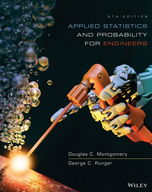Solution Found!
The lengths of the minor and major axes are used to
Chapter 5, Problem 29E(choose chapter or problem)
The lengths of the minor and major axes are used to summarize dust particles that are approximately elliptical in shape. Let X and Y denote the lengths of the minor and major axes (in micrometers), respectively. Suppose that fx(X) = exp(-x), 0 < x and the conditional distribution fY|x(y) = exp[-(y-x)], x < y. Answer or determine the following:
(a) That fY|x(y) is a probability density function for any value of x.
(b) P(X < Y) and comment on the magnitudes of X and Y .
(c) Joint probability density function fxy(x,y).
(d) Conditional probability density function of X given Y = y.
(e) P(Y < 2|X = 1) (f) E(Y|X = 1)
(g) P(X < 1,Y = 1) (h) P(Y < 2)
(i) c such that P(Y < c) = 0.9
(j) Are X and Y independent?
Questions & Answers
QUESTION:
The lengths of the minor and major axes are used to summarize dust particles that are approximately elliptical in shape. Let X and Y denote the lengths of the minor and major axes (in micrometers), respectively. Suppose that fx(X) = exp(-x), 0 < x and the conditional distribution fY|x(y) = exp[-(y-x)], x < y. Answer or determine the following:
(a) That fY|x(y) is a probability density function for any value of x.
(b) P(X < Y) and comment on the magnitudes of X and Y .
(c) Joint probability density function fxy(x,y).
(d) Conditional probability density function of X given Y = y.
(e) P(Y < 2|X = 1) (f) E(Y|X = 1)
(g) P(X < 1,Y = 1) (h) P(Y < 2)
(i) c such that P(Y < c) = 0.9
(j) Are X and Y independent?
ANSWER:
Solution 29E
Step1 of 11:
Let us consider a random variables ‘x, y’ has a joint probability mass function:
for x > 0 and y > x.
Here our goal is:
a). We need to check is a probability density function for any value of x.
b). We need to find also we have to comment on the magnitudes of X and Y.
c). We need to find joint probability density function of
d). We need to find conditional probability density function
e). We need to find
f). We need to find .
g). We need to find
h). We need to find
i). We need to find the value of c such that
j). We need to check whether X and Y independent or not.
Step2 of 11:
a).
A function is said to be a probability density function if the integral over all possible y-values is equal to 1.
Therefore, is a probability density function.
Step3 of 11:
b).
We have that y > x. The same thing has to tell for the joint probability density function and thus we know that the event X < Y is certain to occur. A certain probability has probability 1.
Therefore, Y is always larger than X.
Step4 of 11:
c).
The joint probability density function is:
